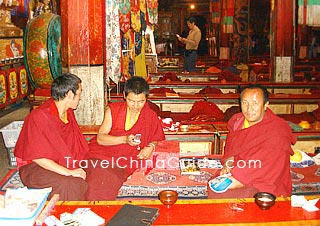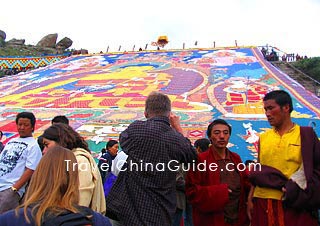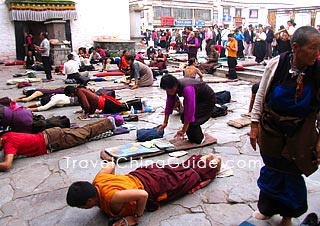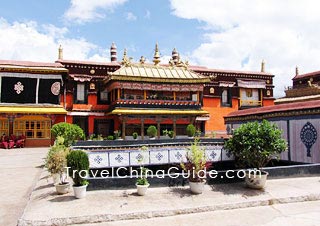Tibetan & Southern Buddhism
Tibetan Buddhism
Also called 'Lamaism', Tibetan Buddhism started in the middle of the 7th century. At that time, King Songtsen Gampo married Nepalese Princess Chizun and Princess Wencheng from Chang'an (currently Xi'an). Influenced by these two Buddhist princesses, he coverted to Buddhism and built Jokhang Temple and Ramoche Monastery (Xiao Zhao Si). In the middle of 8th century, Buddhism was introduced to Tibet via India. Lamaism was totally formed in the late 10th century. After centuries of development in Tibet, a unique combination of religion and politics with Tibetan Buddhism evolved.
|
|
Present Tibetan Buddhism can be divided into four sects: Nyingmapa, Kagyupa, Gelugpa, and Sakyapa.
Nyingmapa means 'old' in Tibetan. Nyingmapa is the oldest sect. It is also called 'Red sect' because monks in this sect always wear red monk hats. The Kagyupa sect was created in the middle of 11th century, and it is famous for having the most branches. It is called 'white sect' because monks belonging to this sect wear white robes and their temples are painted white. In 14th century, Tsong Khapa created Gelugpa sect. This sect encourages monks to live an austere and unselfish life. Monks of this sect wear yellow hats, so it is called 'yellow sect'. In Tibetan, sakyapa means 'colorful'. Temples of the Sakyapa sect are painted in red, white and black stripes, symbolizing Manjusri Bodhisattva, Avalokitesvara and Vajradhara, so it is called the 'colorful sect'.
There are many Tibetan Buddhist monasteries in China, which are worth visiting to experience authentic Tibetan Buddhist culture. Famous Tibetan Buddhist monasteries include: Drepung Monastery, Ganden Monastery, Labrang Monastery, Sakya Monastery, Sera Monastery, Ta'er Monastery and Tashilhunpo Monastery.
Click here for more details about Tibetan Buddhism.
|
|
Southern Buddhism
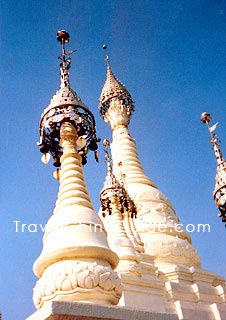 |
| Manfeilong Pagoda, Xishuangbanna, Yunnan |
In 1277 a written Dai language was created and the Pattra sutra appeared. In the Ming Dynasty a Burmese princess was married to a local ruler in Dai area and Burmese monks were sent to Yunnan. A large quantity of Buddhist temples were built in Jinghong . All these helped to popularize Southern Buddhism among the common people.
With its combination of religion and politics, Southern Buddhism, absorbing Tai culture, has flexible doctrines. Monks can eat meat and can secularize. Women do not become nuns for to do so would break their ancestral line.
Generally, Buddhism is the single religion among Dai people and has a comprehensive influence over their daily life and culture like sculpture, painting and folklores. Young boys must go to the temples and learn knowledge until they become adults. Some remain in the temples and become monks while others return to secular life. In a sense, monks assume the role of imparting ethnic culture.
Note:
Typical Southern Buddhist Architectures: Manfeilong Pagoda, Yuantong Temple
![]() Related Link:
Related Link: ![]() Buddhist Architecture
Buddhist Architecture
- Last updated on Aug. 09, 2022 -
